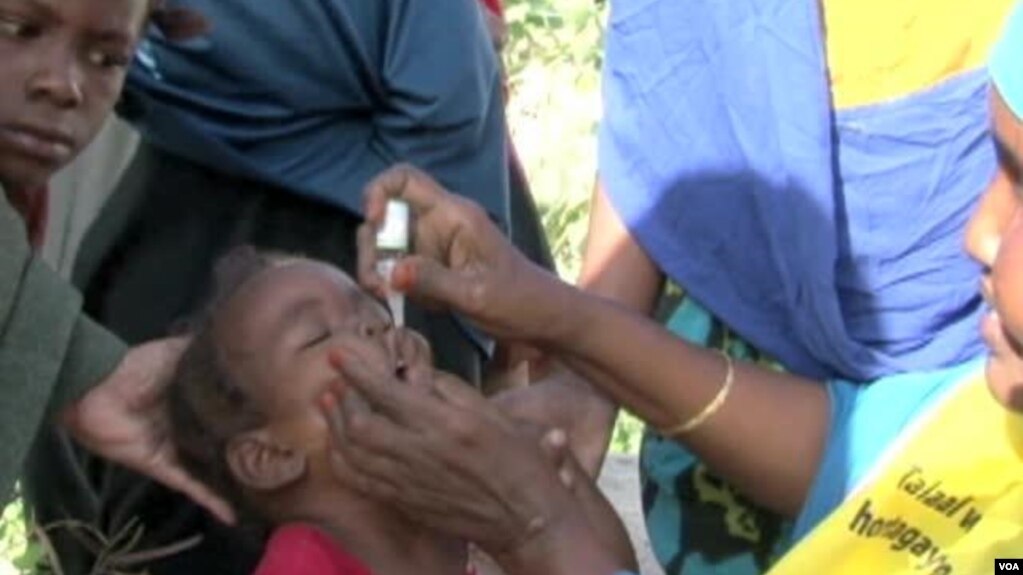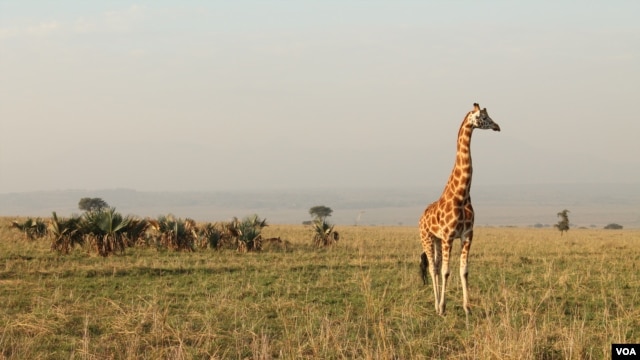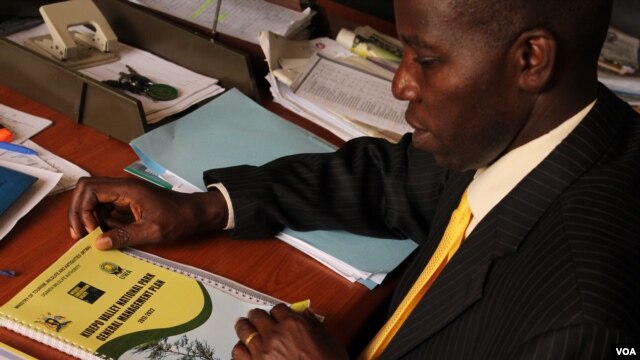
From VOA Learning English, this is As It Is.
Welcome to the show. I’m Caty Weaver.
On the program today, we explore the continuing international effort to end polio following an outbreak of the disease in Africa. Then we go to a beautiful national park in Uganda. Security and roads are improving in the area. Ugandan officials hope such change will help attract more visitors.
Polio Outbreak
The international community came very close earlier this year to stopping polio. But four months ago, the polio virus reappeared. It was discovered in the Horn of Africa, first in Somalia. But health workers are not giving up efforts to stop polio permanently. Jim Tedder reports.
Some experts think the Banadir area of Somalia is what they call the “engine” of the Horn of Africa polio outbreak. The area includes this refugee camp in the country’s capital, Mogadishu.
In June, three-year-old Mohamed Naasir became sick. His mother told VOA that a short time later, one leg of his legs became permanently disabled.
“My son was fine, but he started having a high fever, which lasted for almost four days. I gave him medicine, but there was no change. The following morning, he said to me, ‘Mom, I can’t stand up.’”
The virus has spread at quickly. Major vaccination efforts were started immediately.
Earlier in 2013, polio was contained to three countries: Nigeria, Afghanistan and Pakistan. Health officials have never been able to completely end the polio threat from those countries. But, there were fewer than 100 cases combined.
Since the virus reappeared in eastern Africa, there have been at least 160 polio cases in Somalia alone. It has also spread to Ethiopia and neighboring Kenya.
Genetic experts suggest the virus moving through the Horn of Africa is most similar to the version found in Nigeria.
Partners working to end polio permanently include the World Health Organization, UNICEF and Rotary International. They say the virus can spread more easily in Somalia, which has the largest group of unvaccinated children. Conflict there has kept vaccination crews from being able to reach the children. But a doctor with Rotary International, John Sever, says there are other problems, too.
“The problems of being remote, problems of distrust on the part of the families, the problems of communication, the problems of mapping and realizing where these people are and they migrate from one area to another.”
Many families are suspicious of foreigners, especially from Europe and North America. So, it is important that vaccination crews work with local government and religious leaders, like Sheikh Abdulkadir Mohamed Soomow, a specialist on Islam.
“We urge the people of Somalia to be vaccinated. The doctors tell us that polio can kill and it’s harmful to both adults and children.”
Recently, international partners promised $5.5 billion for a five-year plan to end polio once and for all. Dr. John Sever is hopeful.
“We’re getting closer, that’s the encouraging part."
He says the polio partners know what to do and still hope to end the health threat from polio by 2015.
I’m Jim Tedder.
You are listening to As It Is from VOA Learning English.
Kidepo National Park
This year broadcaster CNN rated Kidepo National Park as the third best park in Africa. On its website, CNN strongly praised the park for its wildlife and natural beauty. CNN noted another reason that Kidepo is great. It said the park has had few visitors.

For years, conflict and insecurity made Kidepo almost impossible to visit. Even now, costly flights and poor roads stop all but the bravest visitors. Recently, Ugandan officials announced steps to open up the park to the wider world.
Kidepo National Park is mostly savannah, or grasslands. The park is far from any city.
It lies just north of Karamoja, an area long considered lawless and violent. To the west is the land terrorized for years by the rebel Lord’s Resistance Army. The area kept Kidepo mostly cut off from the Ugandan capital, Kampala. But a longtime tour guide, Amos Wekesa, says he used to take people there all the same.
“These were extreme risk-takers. I used to take people there under such circumstances, but we always had to make sure we were in a convoy. We had security with us. We could gather in Kotido and have 20 cars following each other. It was a very volatile environment at that time.”
In the past five years, the people of Karamoja have been largely disarmed. The Lord’s Resistance Army has moved to neighboring countries. And now Kidepo is getting some major financing.

Stephen Masaba is with of the Uganda Wildlife Authority. He says the government plans to spend millions of dollars for marketing on Kidepo. He says local transportation will also be improved.
“Security has tremendously improved, and that’s why we’re able to do a lot of these things. We are getting out of the long historical bad days, and we are slowly but surely getting there - putting in place systems that give you access, putting in place gate systems, putting in place systems that can enable you to enjoy. We hope this will turn around the fortunes of Kidepo.”
Mr. Wekesa says this represents a change on the part of the government. Until now, he says, it cared more about agricultural development than tourism development.
“They realize that we are earning a lot of money, and we have a treasure. This is one of the greatest countries in the world in terms of biodiversity. But we have not been able to tap into it, and they realize we should tap into it.”
But problems remain. Travel to Kidepo is difficult even with improved security. Flights from the capital are costly. And park guide Noel Bayo says some roads are in bad condition. He says it can take two days for travelers just to reach Kidepo’s entrance.
“When they get to Kidepo they love the place. But of course, you can understand your frustrations when you get stuck on the road and they have to push, and it’s muddy. This is where the frustration creeps in.”
The government says it has plans to improve the roads around the park. And, Amos Wakesa says tourism numbers have been rising although fewer than two percent of Uganda’s visitors go to Kidepo.
“The thing is, it was starting from nowhere. So the percentages have been so high - 100 percent, 200 percent. Everyone that goes to Kidepo thinks it’s the most beautiful national park they have been to. I’m sure in the next five years it will grow by 1000 percent.”
As a result, Kidepo may lose what some visitors love most about it -- the lack of other people. But that is exactly what the Ugandan government is hoping for.
And that’s AS IT IS for today. I’m Caty Weaver.
What do you want to hear about on As It Is? Let us know. Send an email to learningenglish@voanews.com. Or go our website at learningenglish.voanews.com and click on “Contact Us.”




